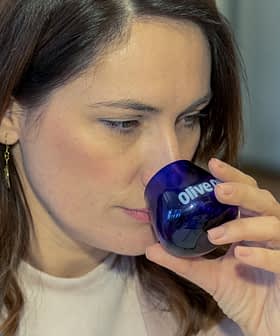The subject of olive oil quality – in particular that of extra virgin olive oil – has been the topic of much discussion recently. A new book, The Extra Virgin Olive Oil Handbook edited by Claudio Peri and published by John Wiley & Sons, Ltd. is a welcome resource for anyone who has been following the olive oil quality conversation, particularly those in the industry who are looking for practical information to help them to produce, promote, buy or sell high quality extra virgin olive oil.

Professor emeritus of food technology at the University of Milan, Claudio Peri’s name may be familiar to readers as the founder of Association 3E, the olive oil quality group that was behind the innovative Beyond Extra Virgin conferences from 2007 to 2011. Although Association 3E no longer exists, this experiment in super-premium olive oil quality production and promotion was an important proving ground for many of the concepts in the book.
This book fills a gap that exists in the current library of English-language olive oil resources. Although there are numerous books available on growing olives, and on cooking with olive oil, there is a dearth of practical material on the making of olive oil. The Extra Virgin Olive Oil Handbook sets out to be an accessible guide for people in the extra virgin olive oil chain: producers, distributors, buyers, retailers and chefs.
The book is in three sections: The product, the process and the process control system. The chapters are authored by different people – mostly Italian experts – but there is consistency in the tone and depth of the material throughout the book. Dr. Peri is a frequent co-author of chapters, as well as the editor, and the book is cohesive and readable, something that is not always the case when a book has so many authors.
“Part I: The product” covers olive oil definitions, standards, composition and cultivars. The material on olive oil composition and nutritional properties is a concise and comprehensible description of what makes up extra virgin olive oil. A rudimentary background in olive oil chemistry is important to understanding issues of olive oil quality, and this chapter does a good job of providing that foundation. The pitfall of Too Much Information is quite well avoided; the authors accept that they are not providing a definitive treatise on olive oil chemistry but rather a primer to help the layperson understand the rest of the book.

A chapter on the role of oxygen and water in olive oil processing is fascinating, setting the stage for the upcoming chapters on malaxation, separation, filtration and storage. The John Wooden mantra “balance is everything” is cited here to illuminate the relationship between oxygen, water and olive oil quality.
The chapter on sensory evaluation of extra virgin olive oil is a good introduction to the topic, outlining official IOC/EC methods and functions, but also touching on the vocabulary and uses of descriptive analysis. It is descriptive analysis that can help buyers find the right oil for their purposes, and for the culinary community to better describe dishes. A chapter at the end of the book on culinary uses of extra virgin olive oil continues the exploration of this crucial interaction of olive oil and food.
“Part II: The process” covers the making of olive oil from harvest to milling to packaging. The information about the process is well-balanced: concise and comprehensible, but not over simplified. A good example of this is the discussion of the time-temperature relationship. Although the easiest thing to say is “always have the shortest possible time between harvest and milling,” an understanding of the importance of the temperature of the fruit and environment helps a producer know whether they are in a three-alarm fire situation or not. The ability to make smart decisions about critical points in the production process can be the difference not only between excellent olive oil and ordinary olive oil, but also between making a profit or not.
The description of the milling process – cleaning, grinding, malaxation, separation – looks at the different steps and their effects on the product. The differences between various options like disc or hammer mills, de-stoned or intact olives, two-phase or three-phase decanters, etc., are well explained. Post-milling steps like filtration, storage and packaging are also covered in a thorough fashion.
“Part III: The process control system” is where it all comes together. The chapter on process management systems looks at integrating various goals and conditions for the production of extra virgin olive oil in a management scheme, and uses risk analysis for identifying critical points.
Product traceability and process certification is addressed in separate chapters, and so are hygiene management and food safety systems (HMS and HACCP). Chapters on olive mill waste and by-products, and life-cycle assessment, look at the environmental impacts of olive oil production and trade.
The production cost of extra virgin olive oil is dissected in its own chapter. It provides a framework that will allow a producer, or would-be producer, to calculate their own real costs by walking them step-by-step through the process. Finally, an appendix provides useful information such as weight to volume conversion tables and information on density, concentration, yield, viscosity, minor components of olive oil and smoke points.
There are parts of this book that will probably stir controversy. As anyone who has been in the industry for any time at all knows, it is easy to get find people with widely divergent opinions about olive oil. The omission of PPP and DAGs in the discussion of olive oil standards, for example, is notable, especially given their importance in recent standards and established retail parameters. But overall the book does an excellent job of presenting a comprehensive guide to extra virgin olive oil in clear, understandable language. It provides a good foundation for further investigation of extra virgin olive oil. This book will be a valuable resource for anyone who wants to improve their production and handling or simply to better understand this complex and fascinating food.








